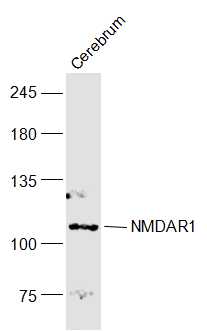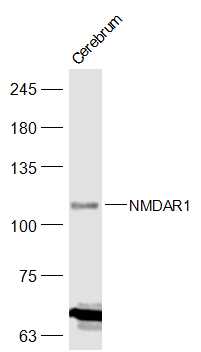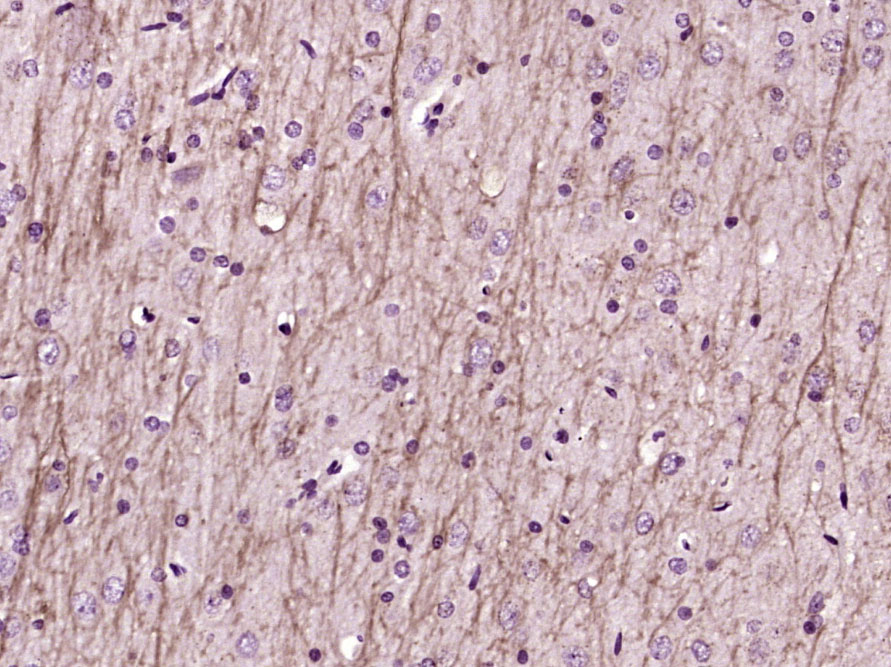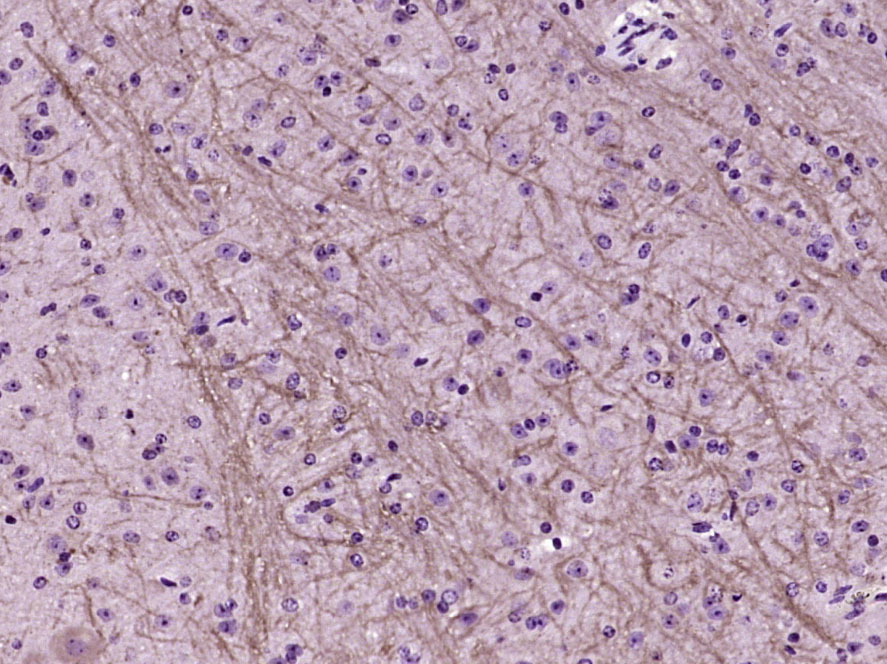
Rabbit Anti-NMDAR1 antibody
NMDA-NR1; N-Methyl-d-Asprtate receptor 1; GRIN1; NMDA1; NR1; Glutamate [NMDA] receptor subunit zeta 1; Glutamate receptor ionotropic N methyl D aspartate 1; Grin 1; Grin1; N methyl D aspartate receptor channel; N-methyl-D-aspartate receptor; N-methyl-D-as
View History [Clear]
Details
Product Name NMDAR1 Chinese Name 离子型谷氨酸受体1抗体 Alias NMDA-NR1; N-Methyl-d-Asprtate receptor 1; GRIN1; NMDA1; NR1; Glutamate [NMDA] receptor subunit zeta 1; Glutamate receptor ionotropic N methyl D aspartate 1; Grin 1; Grin1; N methyl D aspartate receptor channel; N-methyl-D-aspartate receptor; N-methyl-D-aspartate receptor subunit NR1; NMD-R1; NMDA 1; NMDA NR1; NMDA R1; NMDA receptor 1; NMDA1; NMDAR 1; NMDAR; NR 1; NMDZ1_HUMAN. literatures Research Area Cell biology immunology Neurobiology Signal transduction Apoptosis transcriptional regulatory factor The cell membrane受体 Immunogen Species Rabbit Clonality Polyclonal React Species Human, Mouse, Rat, (predicted: Chicken, Dog, Cow, ) Applications WB=1:500-2000 IHC-P=1:100-500 IHC-F=1:100-500 IF=1:100-500 (Paraffin sections need antigen repair)
not yet tested in other applications.
optimal dilutions/concentrations should be determined by the end user.Theoretical molecular weight 103kDa Cellular localization The cell membrane Form Liquid Concentration 1mg/ml immunogen KLH conjugated synthetic peptide derived from human NMDAR1: 831-930/938 <Cytoplasmic> Lsotype IgG Purification affinity purified by Protein A Buffer Solution 0.01M TBS(pH7.4) with 1% BSA, 0.03% Proclin300 and 50% Glycerol. Storage Shipped at 4℃. Store at -20 °C for one year. Avoid repeated freeze/thaw cycles. Attention This product as supplied is intended for research use only, not for use in human, therapeutic or diagnostic applications. PubMed PubMed Product Detail Neuronal Marker
The protein encoded by this gene is a critical subunit of N-methyl-D-aspartate receptors, members of the glutamate receptor channel superfamily which are heteromeric protein complexes with multiple subunits arranged to form a ligand-gated ion channel. These subunits play a key role in the plasticity of synapses, which is believed to underlie memory and learning. Cell-specific factors are thought to control expression of different isoforms, possibly contributing to the functional diversity of the subunits. Alternatively spliced transcript variants have been described. [provided by RefSeq, Jul 2008]
Function:
NMDA receptor subtype of glutamate-gated ion channels with high calcium permeability and voltage-dependent sensitivity to magnesium. Mediated by glycine. This protein plays a key role in synaptic plasticity, synaptogenesis, excitotoxicity, memory acquisition and learning. It mediates neuronal functions in glutamate neurotransmission. Is involved in the cell surface targeting of NMDA receptors.
Subunit:
Forms heteromeric channel of a zeta subunit (GRIN1), a epsilon subunit (GRIN2A, GRIN2B, GRIN2C or GRIN2D) and a third subunit (GRIN3A or GRIN3B); disulfide-linked. Found in a complex with GRIN2A or GRIN2B, GRIN3A or GRIN3B and PPP2CB. Interacts with DLG4 and MPDZ. Interacts with LRFN1 and LRFN2. Interacts with MYZAP.
Subcellular Location:
Cell membrane; Multi-pass membrane protein. Cell junction, synapse, postsynaptic cell membrane. Cell junction, synapse, postsynaptic cell membrane, postsynaptic density. Note=Enriched in post-synaptic plasma membrane and post-synaptic densities.
Post-translational modifications:
NMDA is probably regulated by C-terminal phosphorylation of an isoform of NR1 by PKC. Dephosphorylated on Ser-897 probably by protein phosphatase 2A (PPP2CB). Its phosphorylated state is influenced by the formation of the NMDAR-PPP2CB complex and the NMDAR channel activity.
DISEASE:
Defects in GRIN1 are the cause of mental retardation autosomal dominant type 8 (MRD8) [MIM:614254]. Mental retardation is characterized by significantly below average general intellectual functioning associated with impairments in adaptative behavior and manifested during the developmental period.
Similarity:
Belongs to the glutamate-gated ion channel (TC 1.A.10.1) family. NR1/GRIN1 subfamily.
SWISS:
Q05586
Gene ID:
2902
Database links:Entrez Gene: 2902 Human
Entrez Gene: 14810 Mouse
Omim: 138249 Human
SwissProt: Q05586 Human
SwissProt: P35438 Mouse
Unigene: 558334 Human
Unigene: 278672 Mouse
Unigene: 9840 Rat
Product Picture
Cerebrum (Rat) Lysate at 40 ug
Primary: Anti-NMDAR1 (SL23343R) at 1/1000 dilution
Secondary: IRDye800CW Goat Anti-Rabbit IgG at 1/20000 dilution
Predicted band size: 103 kD
Observed band size: 113 kD
Sample:
Cerebrum (Mouse) Lysate at 40 ug
Primary: Anti-NMDAR1 (SL23343R) at 1/300 dilution
Secondary: IRDye800CW Goat Anti-Rabbit IgG at 1/20000 dilution
Predicted band size: 103 kD
Observed band size: 113 kD
Paraformaldehyde-fixed, paraffin embedded (Rat brain); Antigen retrieval by boiling in sodium citrate buffer (pH6.0) for 15min; Block endogenous peroxidase by 3% hydrogen peroxide for 20 minutes; Blocking buffer (normal goat serum) at 37°C for 30min; Antibody incubation with (NMDAR1) Polyclonal Antibody, Unconjugated (SL23343R) at 1:400 overnight at 4°C, followed by operating according to SP Kit(Rabbit) (sp-0023) instructions and DAB staining.Paraformaldehyde-fixed, paraffin embedded (Mouse brain); Antigen retrieval by boiling in sodium citrate buffer (pH6.0) for 15min; Block endogenous peroxidase by 3% hydrogen peroxide for 20 minutes; Blocking buffer (normal goat serum) at 37°C for 30min; Antibody incubation with (NMDAR1) Polyclonal Antibody, Unconjugated (SL23343R) at 1:400 overnight at 4°C, followed by operating according to SP Kit(Rabbit) (sp-0023) instructions and DAB staining.
Bought notes(bought amounts latest0)
No one bought this product
User Comment(Total0User Comment Num)
- No comment






 +86 571 56623320
+86 571 56623320
 +86 18668110335
+86 18668110335

